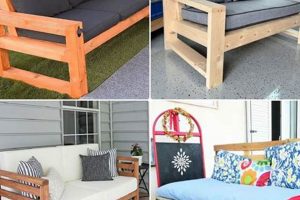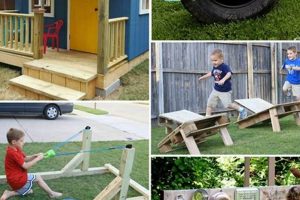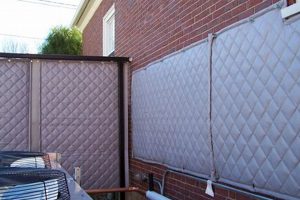A self-constructed writing surface, designed for exterior use, allows for temporary markings that can be easily erased. These typically involve a dark-colored board treated to accept chalk or similar marking materials, and are built by individuals rather than purchased pre-made. For example, a homeowner might create one for their children’s outdoor play area or a restaurant might fashion one to display daily specials.
The appeal of such a project lies in its cost-effectiveness, customization options, and enhancement of outdoor spaces. The ability to tailor size, color, and mounting style ensures that the finished product perfectly complements its surroundings. Historically, these surfaces have served as tools for education, communication, and artistic expression, proving their practical and aesthetic value.
The subsequent sections will detail materials needed, construction methods, surface preparation techniques, and weatherproofing strategies for a durable and attractive finished product.
Construction Tips for a Durable Exterior Writing Surface
The following guidelines are essential for crafting a long-lasting and functional outdoor writing surface. Adherence to these recommendations will ensure the final product withstands environmental elements and provides a reliable communication or artistic tool.
Tip 1: Select Weather-Resistant Materials: Employ exterior-grade plywood or composite boards designed to resist moisture damage. Consider using cedar or redwood for framing elements, as these woods possess natural rot-resistant properties.
Tip 2: Apply a Specialized Coating: Utilize chalkboard paint formulated for outdoor use. These paints typically contain UV inhibitors and enhanced moisture resistance compared to standard interior chalkboard paints.
Tip 3: Ensure Adequate Sealing: Seal all edges and corners of the board with a waterproof sealant. This prevents water penetration, which can lead to warping, cracking, or delamination of the surface.
Tip 4: Construct a Robust Frame: Build a sturdy frame that adequately supports the writing surface and provides a secure mounting point. Consider using galvanized screws or bolts for assembly to prevent corrosion.
Tip 5: Implement Effective Drainage: Design the installation to allow for water runoff. Slightly angling the board or providing a small gap between the board and the mounting surface can prevent water accumulation.
Tip 6: Consider Sun Exposure: Position the finished project in a location that minimizes direct sunlight exposure. Excessive sunlight can cause fading of the chalkboard paint and accelerate material degradation.
Tip 7: Regularly Maintain the Surface: Periodically clean the surface with a damp cloth to remove chalk dust and prevent buildup. Inspect the frame and sealant for signs of damage and address any issues promptly.
These recommendations are crucial for maximizing the longevity and functionality of a writing surface designed for outdoor placement. Diligent application of these strategies will result in a reliable and aesthetically pleasing addition to any exterior space.
The subsequent section will address safety considerations and potential hazards associated with the construction and installation process.
1. Material Selection
Material selection is paramount to the overall performance and longevity of any self-constructed exterior writing surface. The inherent properties of chosen materials directly influence resistance to environmental factors, structural integrity, and the quality of the writing surface.
- Substrate Composition
The base material, typically a sheet of plywood or a composite board, forms the foundation. Exterior-grade plywood, such as Marine or ACX plywood, offers superior resistance to moisture compared to standard interior plywood. Composite boards, manufactured from recycled plastics or wood fibers, provide an alternative with enhanced weather resistance. The choice depends on budget, desired lifespan, and environmental considerations.
- Frame Lumber
The framing lumber provides structural support and defines the perimeter of the writing surface. Pressure-treated lumber offers protection against rot and insect infestation, but may require a sealant to prevent leaching of chemicals. Naturally rot-resistant woods, such as cedar or redwood, provide a chemical-free alternative, though at a higher cost. Proper framing ensures the writing surface remains flat and stable, preventing warping or sagging.
- Fasteners and Hardware
Fasteners, such as screws and bolts, secure the framing and attach the writing surface to the frame. Galvanized or stainless-steel fasteners are essential to prevent corrosion in outdoor environments. The type of hardware used for mountingbrackets, hinges, or hooksshould also be corrosion-resistant and rated for outdoor use. Improper fasteners can lead to structural failure and compromise the integrity of the construction.
- Chalkboard Coating
The chalkboard coating provides the writing surface itself. Specialized exterior chalkboard paints are formulated to withstand UV exposure and resist moisture absorption. These paints typically contain pigments that prevent fading and additives that improve chalk adhesion and erasability. The selection of a high-quality exterior chalkboard paint is crucial for creating a durable and functional writing surface.
The preceding considerations regarding material selection underscore the importance of deliberate planning and informed choices in the construction of a durable, functional exterior writing surface. Each component plays a crucial role in the overall performance and longevity of the final product, ultimately affecting its utility and aesthetic appeal.
2. Paint Formulation
The suitability of the paint formulation directly determines the functionality and longevity of an exterior writing surface. The specific constituents and their proportions dictate the paint’s ability to adhere to the substrate, resist environmental degradation, and provide a receptive surface for chalk. A poorly formulated paint will result in premature failure, rendering the surface unusable.
Exterior chalkboard paint must contain several key components to perform adequately in outdoor conditions. UV inhibitors mitigate fading and prevent chalking caused by prolonged sun exposure. Moisture-resistant resins prevent water absorption, which can lead to blistering, cracking, and delamination. Pigments must be weather-stable to maintain consistent color and contrast over time. The inclusion of additives that enhance chalk adhesion and erasability ensures a functional writing surface. For example, a formulation lacking sufficient UV protection will exhibit rapid fading and chalking in a sunny location, necessitating frequent repainting. Conversely, a paint with excessive moisture permeability will swell and crack in humid environments.
In summation, the paint formulation is a critical determinant of the performance and lifespan of any exterior writing surface. Understanding the role of each component and selecting a product specifically designed for outdoor applications is essential for achieving a durable, functional, and aesthetically pleasing result. Ignoring the specific requirements of exterior environments will inevitably lead to premature failure and increased maintenance costs.
3. Frame Construction
Frame construction is a foundational element in the creation of a durable and functional exterior writing surface. It provides the structural support necessary to withstand environmental stresses and maintains the integrity of the writing surface itself. Proper frame design and execution are crucial for the longevity and usability of the finished project.
- Material Selection for Longevity
The choice of framing material directly impacts the lifespan of the entire structure. Pressure-treated lumber offers resistance to rot and insect infestation, extending the service life. Alternative materials, such as cedar or redwood, provide natural rot resistance. The selection should consider local climate conditions and potential exposure to moisture.
- Joint Design for Stability
The method of joining the frame components significantly affects its overall stability. Mortise and tenon joints, while more complex to construct, provide superior strength and resistance to racking. Simpler joinery methods, such as butt joints secured with screws, can be adequate if reinforced with metal brackets or corner braces. Proper joint design ensures the frame remains square and prevents warping.
- Support for the Writing Surface
The frame must adequately support the writing surface to prevent sagging or flexing. This can be achieved through the use of closely spaced support members or a solid backing panel. The spacing of these supports should be determined by the thickness and rigidity of the writing surface material. Insufficient support can lead to premature failure of the writing surface.
- Mounting Considerations
The frame must be designed to facilitate secure mounting to a wall, fence, or other structure. Attachment points should be strategically located to distribute the weight evenly and prevent stress concentrations. The use of appropriate mounting hardware, such as lag screws or bolts, is essential for a safe and stable installation. Improper mounting can result in the writing surface becoming detached or damaged.
In conclusion, frame construction is not merely an aesthetic consideration but a critical determinant of the structural integrity and lifespan of a self-constructed exterior writing surface. The careful selection of materials, thoughtful joint design, adequate support for the writing surface, and secure mounting provisions are all essential elements for a successful and long-lasting project.
4. Surface Preparation
Surface preparation is a critical determinant in the successful construction of any self-made exterior writing surface. It directly influences the adhesion of subsequent coatings, the overall durability of the finished product, and the clarity of the writing surface itself. Inadequate preparation will invariably lead to premature failure, negating the benefits of high-quality materials and construction techniques.
- Cleaning and Degreasing
Removal of surface contaminants, such as dirt, grease, and mildew, is essential. Residue inhibits paint adhesion, resulting in peeling or flaking. A solution of trisodium phosphate (TSP) or a specialized degreaser is typically employed, followed by thorough rinsing and drying. For instance, neglecting to remove accumulated grease from reclaimed lumber will prevent the chalkboard paint from properly bonding, leading to an uneven and easily damaged surface.
- Sanding and Smoothing
Sanding creates a mechanical bond for subsequent coatings and eliminates surface imperfections. Rough surfaces require coarse-grit sandpaper, followed by progressively finer grits to achieve a smooth, uniform finish. Unsanded surfaces exhibit poor paint adhesion and an uneven texture, detracting from the writing experience. As an example, uneven plywood grain can be smoothed through methodical sanding, creating a receptive surface for the chalkboard paint.
- Priming for Adhesion
Priming provides a uniform base for the chalkboard paint and enhances adhesion. Exterior-grade primers formulated for wood or composite materials are recommended. The primer seals the surface, preventing absorption of the chalkboard paint and ensuring consistent color and texture. Without priming, the chalkboard paint may soak unevenly into the substrate, resulting in a blotchy and less durable finish. Consider, for instance, that using a primer designed for metal on a wooden surface could lead to inadequate sealing and subsequent moisture damage.
- Repairing Imperfections
Prior to coating, any imperfections, such as dents, cracks, or gouges, must be repaired. Wood filler or epoxy can be used to fill these voids, creating a smooth and level surface. Unrepaired imperfections will be visible through the chalkboard paint, detracting from the aesthetic appeal and potentially compromising the structural integrity of the surface. As an illustrative example, a knot hole in the wood, if left unfilled, would create an unusable area on the finished writing surface.
In summary, meticulous surface preparation is an indispensable step in the creation of a functional and durable self-made exterior writing surface. The processes of cleaning, sanding, priming, and repairing imperfections collectively ensure optimal paint adhesion, a smooth writing surface, and extended service life. Neglecting these preparatory measures undermines the entire project, resulting in a substandard and short-lived result.
5. Weather Resistance
The success of any self-constructed exterior writing surface hinges critically on its ability to withstand environmental elements. Weather resistance, therefore, is not merely a desirable attribute but an essential design consideration. A failure to adequately address the impacts of moisture, temperature fluctuations, and ultraviolet radiation will result in rapid deterioration, rendering the surface unusable and negating the effort invested in its creation. The interplay between these factors exerts a constant pressure on the materials and construction techniques employed.
Moisture intrusion, for example, can lead to warping, swelling, and eventual rot in wooden components. Temperature fluctuations induce expansion and contraction, stressing joints and coatings. Ultraviolet radiation degrades paint and surface finishes, causing fading, chalking, and a loss of structural integrity. A practical example involves a chalkboard constructed with untreated plywood and standard interior paint; such a project would likely exhibit signs of deterioration within a single season, with warping, cracking, and peeling becoming evident. In contrast, a board built with exterior-grade materials, sealed edges, and UV-resistant coatings would maintain its functionality and appearance for years.
In conclusion, the inherent connection between environmental durability and project success necessitates a thorough understanding and implementation of weather-resistant strategies. Prioritizing material selection, protective coatings, and robust construction techniques is paramount for ensuring the longevity and continued utility of a self-made exterior writing surface. Addressing these factors proactively mitigates the risks associated with outdoor exposure and maximizes the return on investment in time and materials.
6. Installation Location
The placement of a constructed exterior writing surface significantly influences its longevity, usability, and aesthetic integration within the surrounding environment. Installation location directly impacts exposure to environmental elements, ease of access, and overall functionality. Optimal site selection minimizes wear and tear, maximizes user convenience, and ensures the writing surface complements the intended setting.
The amount of direct sunlight exposure is a primary consideration. Prolonged exposure to ultraviolet radiation accelerates paint degradation, leading to fading and chalking. Installing the writing surface under an overhang or in a shaded area mitigates this effect, extending the life of the finish. Wind exposure also plays a role; strong winds can damage the writing surface, particularly if it is not securely mounted. A sheltered location reduces wind-related stress. Accessibility is another factor; a writing surface intended for children should be installed at an appropriate height and in a safe location, free from hazards. Conversely, a writing surface for posting restaurant specials should be placed in a highly visible area to attract customers. For instance, a chalkboard placed directly under a sprinkler system will require frequent maintenance and will likely suffer from premature coating failure, whereas one strategically placed under the awning of a building will be shielded from direct rain and sunlight, preserving its integrity.
In summary, the choice of installation location is a critical design consideration that influences the durability, functionality, and overall value of a constructed exterior writing surface. Careful evaluation of sunlight exposure, wind exposure, accessibility, and aesthetic integration is essential for ensuring a successful and long-lasting installation. Strategic placement mitigates environmental risks, enhances user experience, and ensures the writing surface remains a valuable asset within its intended environment.
Frequently Asked Questions
This section addresses common inquiries regarding the construction, maintenance, and longevity of exterior writing surfaces.
Question 1: What is the expected lifespan of a self-constructed exterior writing surface?
The lifespan varies significantly depending on material selection, construction techniques, and environmental conditions. A well-constructed board utilizing exterior-grade materials and protective coatings can last for several years with proper maintenance.
Question 2: Is it possible to convert an existing interior chalkboard for outdoor use?
Conversion is possible but requires thorough preparation and the application of exterior-grade sealants and coatings. The existing substrate must be adequately protected from moisture and ultraviolet radiation to prevent damage.
Question 3: What are the best methods for cleaning an outdoor chalkboard?
Regular cleaning with a damp cloth is recommended to remove chalk dust. Stubborn stains can be addressed with a mild detergent solution. Avoid abrasive cleaners, as they can damage the chalkboard surface.
Question 4: How can one prevent chalk from fading or washing away in the rain?
Utilizing high-quality chalk specifically designed for outdoor use is recommended. These chalks typically contain pigments that are more resistant to fading and water damage. However, complete protection from the elements is not guaranteed.
Question 5: What type of sealant is appropriate for protecting the edges of the chalkboard?
A waterproof exterior-grade sealant, such as silicone or polyurethane caulk, is recommended. Apply the sealant liberally to all edges and corners to prevent moisture penetration.
Question 6: Are there any safety precautions to consider during construction?
Appropriate safety gear, including eye protection, gloves, and a dust mask, should be worn during cutting, sanding, and painting. Work in a well-ventilated area when using paints or sealants. Ensure the finished product is securely mounted to prevent accidents.
Proper construction and maintenance are crucial for maximizing the lifespan and functionality of an exterior writing surface.
The following section will provide a summary of key considerations for a successful project.
Concluding Remarks
This exploration has detailed the critical aspects of constructing a functional and durable diy outdoor chalkboard. Material selection, proper surface preparation, robust frame construction, weather resistance implementation, and strategic installation are all essential considerations. Neglecting any of these factors can significantly compromise the lifespan and usability of the finished product.
The creation of a diy outdoor chalkboard represents a commitment to both practicality and aesthetic enhancement. Diligent application of the principles outlined herein will yield a valuable asset, capable of serving as a tool for communication, education, or artistic expression for years to come. Careful planning and execution are paramount for realizing the full potential of this endeavor.







